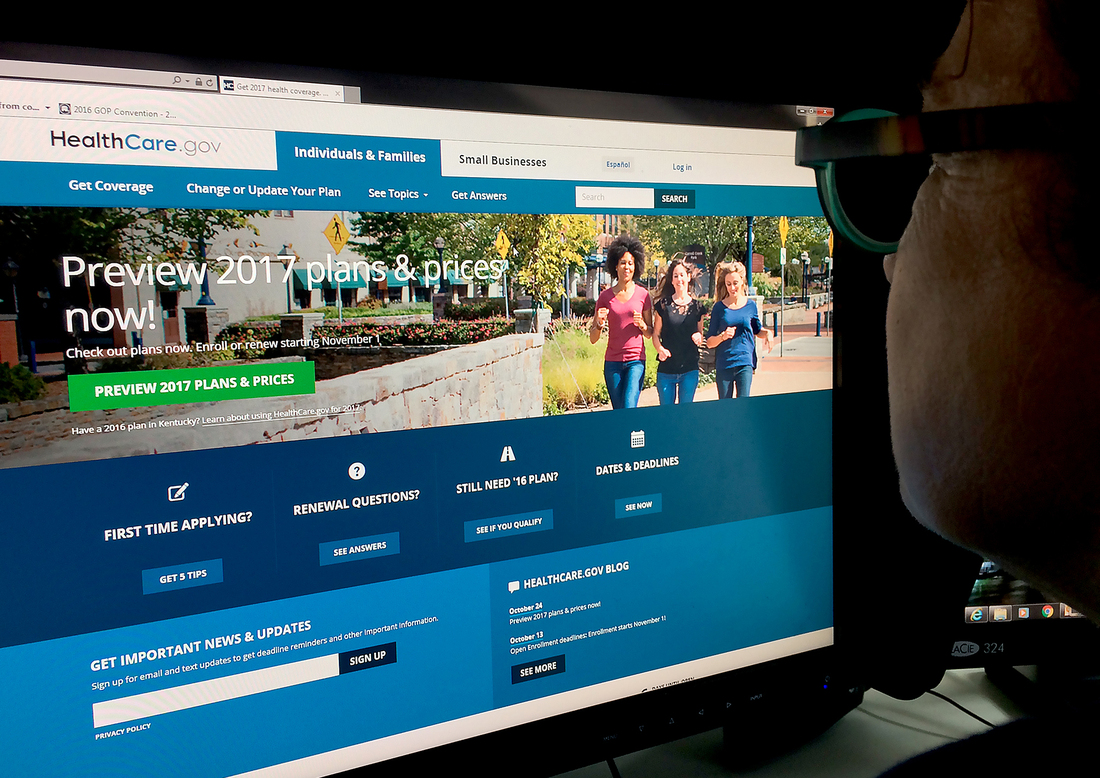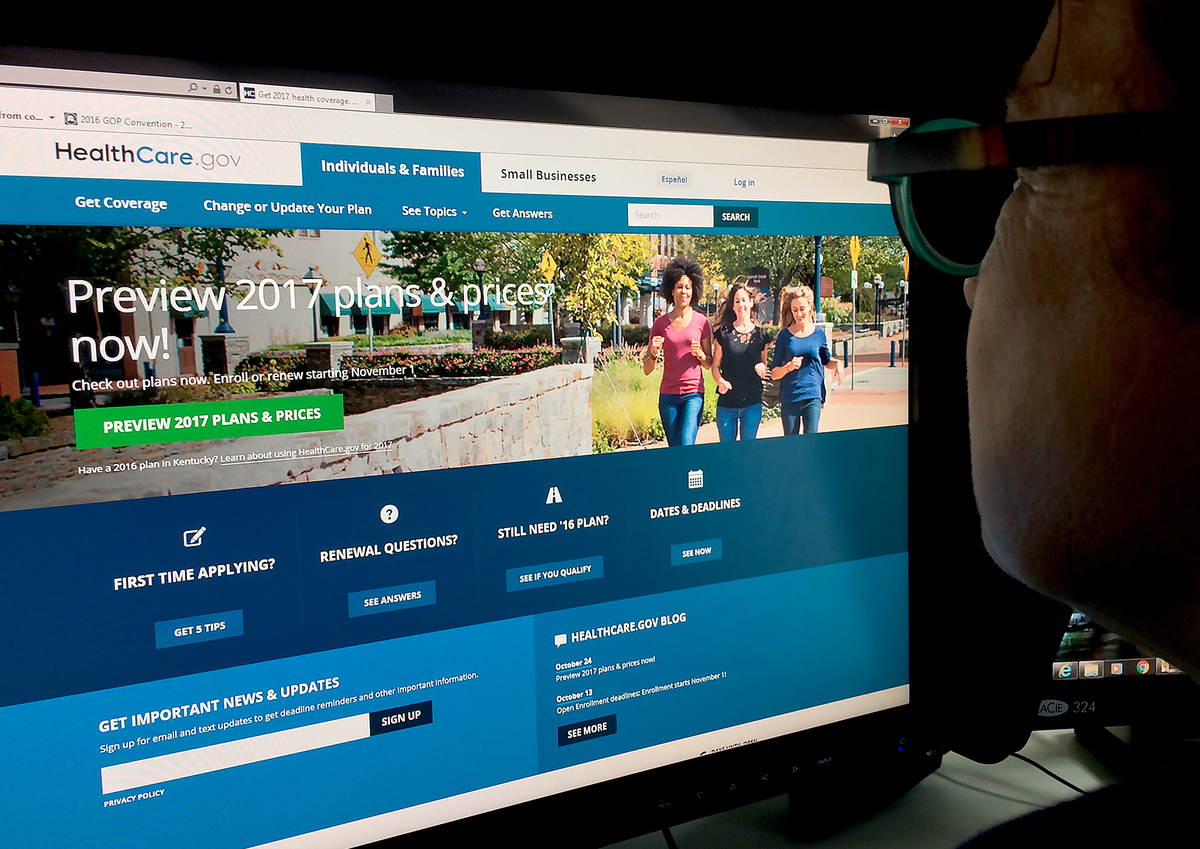Hunting For A Health Plan? Bronze May Be Your Best Value - NPR
[ad_1]

HealthCare.gov has already begun showcasing health plans and prices for 2017.
Karen Bleier/AFP/Getty Images
hide caption
toggle caption
Karen Bleier/AFP/Getty Images

HealthCare.gov has already begun showcasing health plans and prices for 2017.
Karen Bleier/AFP/Getty Images
As customers this week begin shopping for 2017 health insurance on HealthCare.gov and state exchanges, which is a better buy, overall: a bronze plan, or silver? And will the IRS go after taxpayers next year who don't repay the subsidies they got — but didn't ultimately qualify for — in 2016? Here are the answers to some recent questions from readers.
I know that silver plans are the most popular type of coverage on the marketplace, but bronze plans are often a lot cheaper. Are there circumstances when I should consider buying bronze?
Bronze plans may make sense for some people, including those who are healthy and don't expect to use much health care, as well as those who are sick and expect to use a lot of it. While the out-of-pocket spending limit for both bronze and silver plans is often similar, the monthly premium for bronze plans is generally significantly lower.
Look carefully at the total amount you might be responsible for paying out of pocket with each type of plan, in addition to the specifics of coverage and provider networks.
If you typically use minimal health care services, you may be willing to risk the higher deductible of a bronze plan, which is likely to top $5,700, compared with about $3,000 for a silver plan. (Overall, bronze plans pay 60 percent of health care expenses, on average, while silver plans pay 70 percent.)
And if you have an expensive condition and know you're likely to blow through your deductible and hit your out-of-pocket spending limit for the year anyway, a bronze plan may also make financial sense.
In 2016, the average maximum out-of-pocket spending limit for bronze plans has been $6,631, while the average silver limit is $475 lower at $6,156, according to Avalere Health. (By law, the spending limit on any individual plan this year can be no higher than $6,850. Next year it rises to $7,150.)
Meanwhile, the average monthly premium this year for a 50-year-old is $408 for bronze plans, versus $496 for silver plans — a savings of $88 per month, or $1,056 annually, according to Avalere.
In this example, people who reach their out-of-pocket maximum during the year would each save $581, on average, if they were in a bronze plan instead of in a silver one.
"For people who have high health care spending, the bronze plan is often the cheapest out-of-pocket spending overall," said Caroline Pearson, a senior vice president at Avalere.
There's one important exception: If your income is less than 250 percent of the federal poverty level (about $30,000), you can qualify for a cost-sharing subsidy that reduces your deductible, copayments and out-of-pocket spending limit. But you must buy a silver plan in order to get the subsidy.
Still, Pearson says, for people who tend to have high health care costs, one potential downside of buying a cheaper plan with a higher deductible is the higher amount you'll have to shell out up front. The plan pays 100 percent of your costs for in-network care — but only after you hit that out-of-pocket spending cap.
When I sign up for health insurance on the marketplace this year, is there any reason I shouldn't underestimate my income to get a bigger tax credit? I thought the Internal Revenue Service couldn't come after people for repayment.
When you apply for coverage on the marketplace you have to attest that you're providing accurate information, otherwise you could face penalties.
Apart from that, you're confused about a couple of things.
Most people must have health insurance or pay a penalty. This year, the penalty is the greater of $695 per adult, or 2.5 percent of income. If you don't make that payment, the IRS can deduct it from your income tax refund, but it can't use many other enforcement tools to collect the money.
However, tax credits for monthly health insurance premiums are handled differently. As you note, people with incomes up to 400 percent of the federal poverty level (about $47,000 for one person) can qualify for those credits to help pay for their premiums.
If you underestimate your income and receive too much in advance premium tax credits, you'll generally have to repay the excess. If you don't repay it, the IRS can use liens and levies to collect what it's owed, and may charge interest and penalties to boot, says Mark Luscombe, principal federal tax analyst at Wolters Kluwer Tax and Accounting, a consulting and software provider for tax professionals.
And the exchange isn't going to just take your word for it when you estimate your income. The marketplace will compare your estimated income to your tax filings and Social Security information — and will ask you for documentation if your estimated income for next year differs substantially from what's on file, says Timothy Jost, an emeritus professor at Washington and Lee University School of Law in Virginia.
If you do get too much in tax credits, your repayment is generally capped at between $300 and $2,500, if your income is less than 400 percent of the poverty level. People with higher incomes have to repay the full amount.
As of last December, 1.8 million taxpayers had filed 2014 returns that entailed excess advance premium tax credits of $1.6 billion that was required to be repaid, according to a report from the Treasury Inspector General for Tax Administration. Most people repaid what they owed; only 39,000 of those taxpayers — 2 percent of the total — had unpaid assessments at the end of the year, the report found.
Kaiser Health News is an editorially independent news service that is part of the nonpartisan Henry J. Kaiser Family Foundation. Michelle Andrews is on Twitter: @mandrews110.
[ad_2]

No comments :